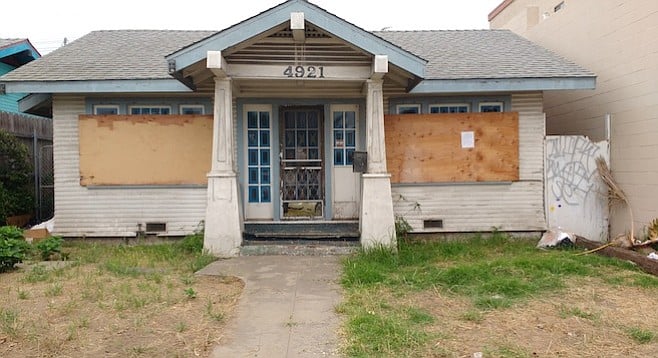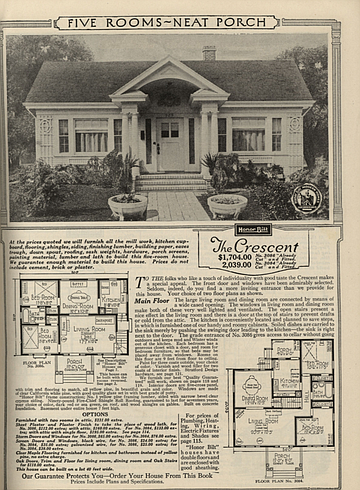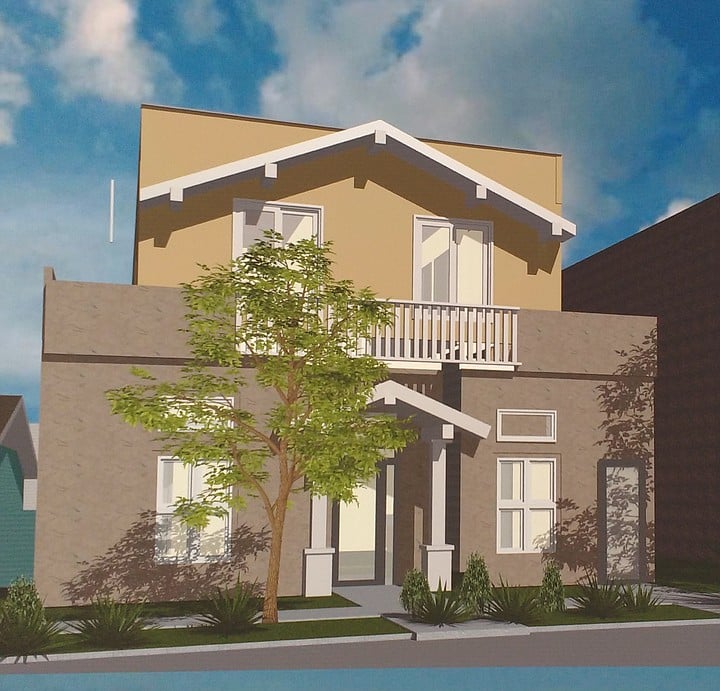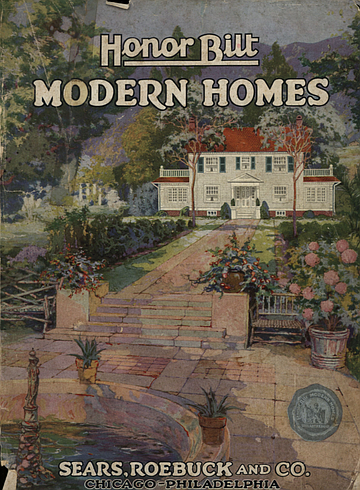 Facebook
Facebook
 X
X
 Instagram
Instagram
 TikTok
TikTok
 Youtube
Youtube

Sears is no longer the retailer it once was, having been beaten to the brink of irrelevance by outlet closures and online competition. But just about anyone over 40 remembers the company’s trusty, phone-book-sized tome that contained every need, want, and whim that could conceivably be sold to an American consumer: the mail-order catalog.

Once upon a time in Ocean Beach, a fellow who bought a vacant lot at 4921 Voltaire Street may well have been flipping through a Sears, Roebuck and Co. catalog to get inspiration for his future house. Not for the furnishings, but for every piece necessary to build the structure itself — which, by some estimates, would have included 30,000 or so parts weighing some 25 tons, arriving to the lot by rail boxcar and truck.
William Feigley, a recent arrival from Kansas, didn’t want to build here for the now-famous O.B. vibe. This was the mid-1920s, many decades before the area would attain its status as a free-wheeling beach community. Most likely, according to a research report, Feigley was looking to build quickly, find a buyer, and cash out.
And in the early 20th Century, building a Sears kit home — a “Lincoln Logs on steroids,” in the words of one aficionado — seemed like a serviceable and efficient way to get the job done.
If it’s true, the structure the city has dubbed the William and Ona Feigley Spec House #1 would be one of some 70,000–75,000 homes Sears sold between 1908 and 1940, according to searsachives.com, a website maintained by the company.
No one knows how many Sears kit homes are still standing, but their owners share a camaraderie online, with several websites devoted to swapping stories, how-to advice for preserving and enhancing their homes, and research tips.
But one person’s dandy is another person’s dump, and the days appear to be numbered for the Feigley House.

The one-story Craftsman-style cottage has been vacant for years. It may literally be a shell of its former self — the building was gutted of its bedrooms in the 1980s when it was converted to a doctor’s office. Records of its occupancy since the medical practice left in 1989 are spotty. Complaints about squatters, trash, vandalism, and weeds have been rampant.
It came as little surprise, then, when new owners who took possession of the property last year came forward with a plan to demolish the Feigley House.
Owners plan to build a two-story structure with commercial space on the ground level, two apartments on the second floor, and a rooftop deck. Two months ago, the proposal attained slam-dunk status when the Ocean Beach Planning Board gave its near-unanimous blessing. Boardmembers praised the architect for altering the original design to the board’s liking and achieving a more Craftsman-style look, even agreeing to incorporate portions of the existing entrance in the new building.
But that proposal almost never saw the light of day. At the October 27, 2016, hearing of the city’s Historic Resources Board, staff recommended designating the Feigley House as a historic resource, which would have all but prevented its destruction.

Despite its blemished appearance, the Feigley House has maintained integrity in terms of design, materials, and feeling, according to the staff report. Nearly a century after its construction, the prized characteristics of its Craftsman-style architecture continue to shine through, said assistant planner Suzanne Segur, one of the report’s authors.
“Specifically, the resource exhibits a gable roof with wide eave overhang, wood cladding, decorative beams, a partial width porch with tapered square columns, wood-frame sash windows, and decorative attic vents,” Segur told the board.
It was the owner’s side that advanced the kit-home theory at the hearing, charging such an origin didn’t enhance but actually weakened historical value.
A document called the "Historic Resource Research Report," prepared by the architectural firm Brian F. Smith and Associates on behalf of the owners, asserted the Feigley House bears a telling resemblance to a “Crescent” kit home, one of the 120 models described in the Sears “HonorBilt Modern Homes” 1921 catalog.
As such, the home is “not architecturally significant,” Scott A. Moomjian, an attorney who has represented owners with historic properties, told the board.
So even if the Feigley House hadn’t been damaged, Moomjian said, by insect infestation, neglect, and weathering, it would still be nothing but a “common, undistinguished, and ordinary Craftsman home” that fell far short of being “considered an important architectural specimen.”
The adjacent property owners on Voltaire Street agreed with that assessment, said one of the owners, Sean Gogarty, of San Francisco. He said his daughter would likely run an educational therapist business on the first floor.
“Our neighbors are excited to have this building removed and replaced,” Gogarty said.
No consensus was reached about the Feigley House’s status as a Sears home. Segur said evidence was insufficient. However, the only boardmember to address that issue, assistant chair Dr. Ann Woods, found the prospect appealing. “I think kit homes are an important aspect of the Craftsman style,” Woods said, calling them “historically interesting and important.”
When it came time to vote, only three boardmembers supported historic designation — far short of the required six.
But to Woods’s point: are kit homes interesting and important?
It’s easy to understand the passion of the Sears kit-home community. The Crescent, which appears on page 29 of the 1921 catalog (between the “Ardara” and “Martha Washington” models) was intended for “folks who like a touch of individuality with good taste,” according to the description.
For as little as $1704, Feigley would have received everything except “cement, brick and plaster,” including “all the millwork, kitchen cupboard, flooring, shingles, siding, finishing lumber, building paper, eaves trough, downspout, roofing, sash weights, hardware, porch screens, painting material, lumber and lath.”
With “no sawing required” and “every piece cut and fitted, ready for its place,” Feigley would stand to save 40 percent in carpenter labor, the catalog states.
As for the design, it was more than properly vetted for the standards of the day. “Every plan is passed upon by women experts,” the catalog states. “Architects and women advisors plan economy of space.... We plan the arrangement of the kitchen to save steps for the housewife.”
As an “HonorBilt” model — the highest quality of Sears’ three lines — it boasted No. 1 yellow pine framing lumber and cypress siding. Perhaps the most highly touted feature of the Crescent was its “neat porch.”
“Seldom, indeed, do you find a more inviting entrance than we provide for this house,” the catalog states.
One of the best-known kit homes in Southern California (though probably not a Sears product) was reportedly built by Frank Nixon in the 1910s. It would become the home for Nixon, his wife Hannah, and the five Nixon boys, including the one named Richard Milhouse. Today, the kit home is “one of the showpieces of the Nixon Presidential Library & Museum, getting thousands of visitors each year,” according to the Orange County Register.
Walt and Roy Disney also reportedly built kit homes to live in, which are still standing.
Preservationists didn’t like the Historic Resource Board’s ruling, nor the way the Smith report dissed kit houses.
“[T]his in no way discounts the historicity of this Craftsman bungalow,” said Bruce Coons, executive director of Save Our Heritage Organisation, in a letter to the board.
“On the contrary, catalog buildings also have their place in the development of the Ocean Beach community…,” the letter stated.
If the Feigley House can’t remain at its current address, could it be moved elsewhere? That’s what Coons and his organization want.
“[W]hen a building has been cleared and is still very clearly an intact historic resource, we support relocating the building, but preferably still within the same neighborhood,” Amie K. Hayes, a Heritage Organisation historic resources specialist, said in an email.
At the Ocean Beach Planning Board meeting, Kent Smith, the owner’s architect, said the building’s “poor shape” made the prospect of moving it all but cost-prohibitive. He recalled a building in Hillcrest relocated from the corner of Fifth and Washington “that ended up being, like, a $120,000 proposition.”
If the owners allowed it, anyone interested “could have it for nothing,” Smith said. But he stressed such a move would have to be completed within a few months.
Whether such a transaction is in the works is unclear. Hayes said recently she had been contacted by a “local” who wants to move it but didn’t provide further details. Smith referred inquiries to Gogarty, who didn’t respond to voicemails.


Sears is no longer the retailer it once was, having been beaten to the brink of irrelevance by outlet closures and online competition. But just about anyone over 40 remembers the company’s trusty, phone-book-sized tome that contained every need, want, and whim that could conceivably be sold to an American consumer: the mail-order catalog.

Once upon a time in Ocean Beach, a fellow who bought a vacant lot at 4921 Voltaire Street may well have been flipping through a Sears, Roebuck and Co. catalog to get inspiration for his future house. Not for the furnishings, but for every piece necessary to build the structure itself — which, by some estimates, would have included 30,000 or so parts weighing some 25 tons, arriving to the lot by rail boxcar and truck.
William Feigley, a recent arrival from Kansas, didn’t want to build here for the now-famous O.B. vibe. This was the mid-1920s, many decades before the area would attain its status as a free-wheeling beach community. Most likely, according to a research report, Feigley was looking to build quickly, find a buyer, and cash out.
And in the early 20th Century, building a Sears kit home — a “Lincoln Logs on steroids,” in the words of one aficionado — seemed like a serviceable and efficient way to get the job done.
If it’s true, the structure the city has dubbed the William and Ona Feigley Spec House #1 would be one of some 70,000–75,000 homes Sears sold between 1908 and 1940, according to searsachives.com, a website maintained by the company.
No one knows how many Sears kit homes are still standing, but their owners share a camaraderie online, with several websites devoted to swapping stories, how-to advice for preserving and enhancing their homes, and research tips.
But one person’s dandy is another person’s dump, and the days appear to be numbered for the Feigley House.

The one-story Craftsman-style cottage has been vacant for years. It may literally be a shell of its former self — the building was gutted of its bedrooms in the 1980s when it was converted to a doctor’s office. Records of its occupancy since the medical practice left in 1989 are spotty. Complaints about squatters, trash, vandalism, and weeds have been rampant.
It came as little surprise, then, when new owners who took possession of the property last year came forward with a plan to demolish the Feigley House.
Owners plan to build a two-story structure with commercial space on the ground level, two apartments on the second floor, and a rooftop deck. Two months ago, the proposal attained slam-dunk status when the Ocean Beach Planning Board gave its near-unanimous blessing. Boardmembers praised the architect for altering the original design to the board’s liking and achieving a more Craftsman-style look, even agreeing to incorporate portions of the existing entrance in the new building.
But that proposal almost never saw the light of day. At the October 27, 2016, hearing of the city’s Historic Resources Board, staff recommended designating the Feigley House as a historic resource, which would have all but prevented its destruction.

Despite its blemished appearance, the Feigley House has maintained integrity in terms of design, materials, and feeling, according to the staff report. Nearly a century after its construction, the prized characteristics of its Craftsman-style architecture continue to shine through, said assistant planner Suzanne Segur, one of the report’s authors.
“Specifically, the resource exhibits a gable roof with wide eave overhang, wood cladding, decorative beams, a partial width porch with tapered square columns, wood-frame sash windows, and decorative attic vents,” Segur told the board.
It was the owner’s side that advanced the kit-home theory at the hearing, charging such an origin didn’t enhance but actually weakened historical value.
A document called the "Historic Resource Research Report," prepared by the architectural firm Brian F. Smith and Associates on behalf of the owners, asserted the Feigley House bears a telling resemblance to a “Crescent” kit home, one of the 120 models described in the Sears “HonorBilt Modern Homes” 1921 catalog.
As such, the home is “not architecturally significant,” Scott A. Moomjian, an attorney who has represented owners with historic properties, told the board.
So even if the Feigley House hadn’t been damaged, Moomjian said, by insect infestation, neglect, and weathering, it would still be nothing but a “common, undistinguished, and ordinary Craftsman home” that fell far short of being “considered an important architectural specimen.”
The adjacent property owners on Voltaire Street agreed with that assessment, said one of the owners, Sean Gogarty, of San Francisco. He said his daughter would likely run an educational therapist business on the first floor.
“Our neighbors are excited to have this building removed and replaced,” Gogarty said.
No consensus was reached about the Feigley House’s status as a Sears home. Segur said evidence was insufficient. However, the only boardmember to address that issue, assistant chair Dr. Ann Woods, found the prospect appealing. “I think kit homes are an important aspect of the Craftsman style,” Woods said, calling them “historically interesting and important.”
When it came time to vote, only three boardmembers supported historic designation — far short of the required six.
But to Woods’s point: are kit homes interesting and important?
It’s easy to understand the passion of the Sears kit-home community. The Crescent, which appears on page 29 of the 1921 catalog (between the “Ardara” and “Martha Washington” models) was intended for “folks who like a touch of individuality with good taste,” according to the description.
For as little as $1704, Feigley would have received everything except “cement, brick and plaster,” including “all the millwork, kitchen cupboard, flooring, shingles, siding, finishing lumber, building paper, eaves trough, downspout, roofing, sash weights, hardware, porch screens, painting material, lumber and lath.”
With “no sawing required” and “every piece cut and fitted, ready for its place,” Feigley would stand to save 40 percent in carpenter labor, the catalog states.
As for the design, it was more than properly vetted for the standards of the day. “Every plan is passed upon by women experts,” the catalog states. “Architects and women advisors plan economy of space.... We plan the arrangement of the kitchen to save steps for the housewife.”
As an “HonorBilt” model — the highest quality of Sears’ three lines — it boasted No. 1 yellow pine framing lumber and cypress siding. Perhaps the most highly touted feature of the Crescent was its “neat porch.”
“Seldom, indeed, do you find a more inviting entrance than we provide for this house,” the catalog states.
One of the best-known kit homes in Southern California (though probably not a Sears product) was reportedly built by Frank Nixon in the 1910s. It would become the home for Nixon, his wife Hannah, and the five Nixon boys, including the one named Richard Milhouse. Today, the kit home is “one of the showpieces of the Nixon Presidential Library & Museum, getting thousands of visitors each year,” according to the Orange County Register.
Walt and Roy Disney also reportedly built kit homes to live in, which are still standing.
Preservationists didn’t like the Historic Resource Board’s ruling, nor the way the Smith report dissed kit houses.
“[T]his in no way discounts the historicity of this Craftsman bungalow,” said Bruce Coons, executive director of Save Our Heritage Organisation, in a letter to the board.
“On the contrary, catalog buildings also have their place in the development of the Ocean Beach community…,” the letter stated.
If the Feigley House can’t remain at its current address, could it be moved elsewhere? That’s what Coons and his organization want.
“[W]hen a building has been cleared and is still very clearly an intact historic resource, we support relocating the building, but preferably still within the same neighborhood,” Amie K. Hayes, a Heritage Organisation historic resources specialist, said in an email.
At the Ocean Beach Planning Board meeting, Kent Smith, the owner’s architect, said the building’s “poor shape” made the prospect of moving it all but cost-prohibitive. He recalled a building in Hillcrest relocated from the corner of Fifth and Washington “that ended up being, like, a $120,000 proposition.”
If the owners allowed it, anyone interested “could have it for nothing,” Smith said. But he stressed such a move would have to be completed within a few months.
Whether such a transaction is in the works is unclear. Hayes said recently she had been contacted by a “local” who wants to move it but didn’t provide further details. Smith referred inquiries to Gogarty, who didn’t respond to voicemails.
Comments